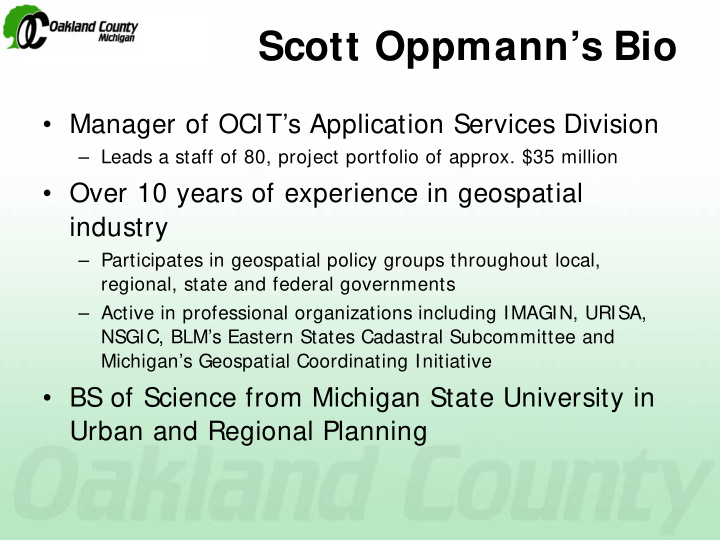



Scott Oppmann’s Bio • Manager of OCIT’s Application Services Division – Leads a staff of 80, project portfolio of approx. $35 million • Over 10 years of experience in geospatial industry – Participates in geospatial policy groups throughout local, regional, state and federal governments – Active in professional organizations including IMAGIN, URISA, NSGIC, BLM’s Eastern States Cadastral Subcommittee and Michigan’s Geospatial Coordinating Initiative • BS of Science from Michigan State University in Urban and Regional Planning
It’ ’s Not About the s Not About the It Data Anymore… …. . Data Anymore Scott Oppmann, Manager Application Services Division Oakland County Information Technology
County Overview County budget is approximately $500 million County budget is approximately $500 million 4.19 mills – lowest county rate in Michigan 4.19 mills – lowest county rate in Michigan Located 30 miles north of the City of Detroit Located 30 miles north of the City of Detroit Central IT Dept under County Executive Central IT Dept under County Executive 62 local governmental units (CVTs) 62 local governmental units (CVTs) 150 Employees plus Contract Resources 150 Employees plus Contract Resources Annual Budget approximately $40 Million Annual Budget approximately $40 Million 910 square miles and 450,000 parcels 910 square miles and 450,000 parcels 2000 Census population of 1.2 million 2000 Census population of 1.2 million Added $50 billion in property value Added $50 billion in property value in the last five years in the last five years
Organizational Context • Growing suburb with a rich set of natural and cultural features • Like many suburban communities, wrestling with: – Infrastructure Costs – Natural Feature Preservation – Quality of Life – Business Attraction / Retention – Homeland Security – Budget Constraints (integrated services & systems)
Technology Vision Common taxpayers • – County and CVTs; ISD and school districts Enterprise deployments • Promote data integration • – Horizontal – Vertical Recognize full range of benefits • Promote “Information Capital” •
Oakland County’s GI S Evolution Disparate Base Map Data Disparate Base Map Data Enterprise GIS Data Management Enterprise GIS Data Management Multiple Software Platforms Multiple Software Platforms ArcGIS and RDBMS Migration ArcGIS and RDBMS Migration Lacked Central Coordination Lacked Central Coordination Centralized and Federated Geospatial Teams Centralized and Federated Geospatial Teams Specialized Hardware Specialized Hardware Expertise Leveraged Throughout County Expertise Leveraged Throughout County Limited Data Sharing Limited Data Sharing Integral Part of Business Applications Integral Part of Business Applications Limited Impact on Business Processes Limited Impact on Business Processes Base Map Data Coordinated Base Map Data Coordinated Common Software Platform (ESRI) Common Software Platform (ESRI) Central Coordinating Organization Created Central Coordinating Organization Created Open Hardware Platform Deployed Open Hardware Platform Deployed Data and Common Knowledge Leveraged Data and Common Knowledge Leveraged Apps Developed to Support Business Processes Apps Developed to Support Business Processes Early 1990s Mid 1990s Early 2000s Industry Trends: Specialized Hardware, Many Software Providers, Industry Trends: Specialized Hardware, Many Software Providers, Difficult to Manage Data Difficult to Manage Data Industry Trends: Intel-based Hardware, Market-Leading Software Provider, Industry Trends: Intel-based Hardware, Market-Leading Software Provider, RDBMS Storage Emerges RDBMS Storage Emerges Industry Trend: Diverse Hardware, Prominent Software Provider, Industry Trend: Diverse Hardware, Prominent Software Provider, RDBMS Prevalent RDBMS Prevalent
Where are we going? (The Vision) A geographically organized Oakland County where location is imbedded as an integral part of information management, is used to formulate environmental, social, safety and economic policies, and where access to this geographically organized data provides citizens with an enhanced opportunity to participate in the governance of their community
I mplications of Vision Statement • Geospatial technology and data are: – Integral parts of the business applications and enterprise IT architecture – Recognized as an “asset” in the organization – Widely available to citizens, government agencies, and educational community • Pervasive, yet transparent, geography is promoted
Geography is now a large component of I nternet Search Technology
“…would like to see the equivalent of Wikipedia – Geopedia”. Vint Cerf, Chief Evangelist at Google, Inc. “…worries that even the best-intentioned amateur could provide inaccurate data that could lead to a disaster. Who wants to dig a hole and run into a pipe?” Jack Dangermond, President of ESRI “…providing access to GIS tools, you’ll end up with a big number of users converging on the truth.” Michael Jones, Google Earth’s Chief Technologist Source: Computerworld; August 2007
Background (Focused on Data) • Government Activities – FGDC Framework Implementation – Imagery for the Nation – Cadastral – Local government • Private Sector Activities – ESRI Data Model Templates – Google, Microsoft, TeleAtlas, Zillow, etc.
Modern Day Scenario
The Future • While data custodianship continues to be a major focus of geospatial activities in government, the focus is shifting • Advent of Web 2.0, has shifted focus to consumer markets demanding more and more data/services – Geospatial community needs to stop dinking! – Precision and accuracy have been replaced by collaboration and use • Developing examples of application and use at a tremendous pace
External Forces • Online content providers have redefined modern base map and user experience – Imagery, transportation, and rooftop addresses • Bypassing government data providers and leveraging private sector extensively • Making enormous capital investments!
Call to Action • Get our act together soon – If we don’t, the private sector is going to do it for us • Become the trusted source for geospatial data – Protect value and integrity because its so vital to commerce – Reduce time to market • Challenge our publication models • Focus on knowledge, not commodities – Business application integration • Embrace private sector
Questions/ Answer
Recommend
More recommend